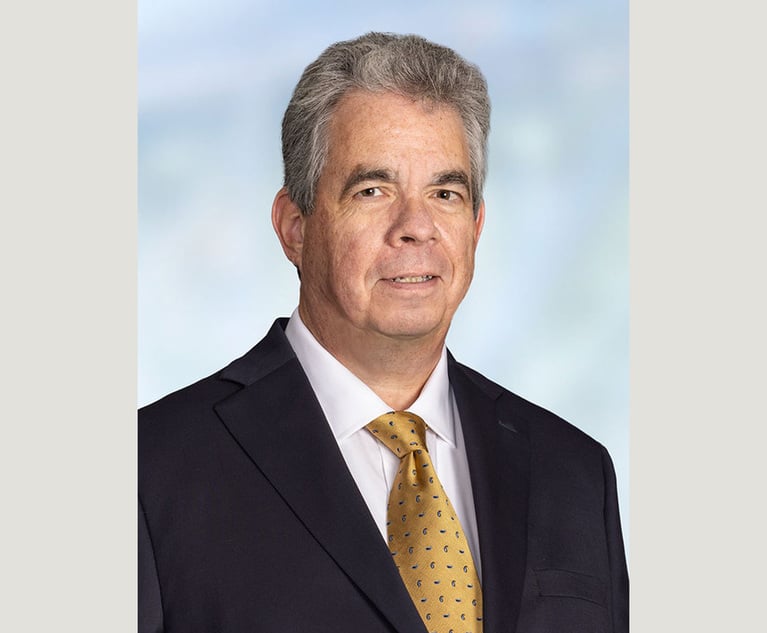 Rebecca Rosenberger Smolen, left, and Amy Neifeld Shkedy, right, of Bala Law Group.
Rebecca Rosenberger Smolen, left, and Amy Neifeld Shkedy, right, of Bala Law Group.The Role of Powers of Appointment in Trusts
Our typical approach is to design trusts to last for a beneficiary's lifetime (as opposed to terminating upon a selected age at which it is hoped financial maturity would have been attained), while permitting discretionary distributions to a beneficiary to the extent that a beneficiary may need to access the trust funds.
June 29, 2020 at 10:13 AM
7 minute read
In our articles, we often highlight the importance of incorporating trusts into estate plans. We have found that more and more clients seek to leave their assets (whether at a client's death or through lifetime gifting) in trusts for their children (or other intended beneficiaries) for numerous reasons, whether it be for tax planning, creditor protection, spendthrift protection or all of the above. Our typical approach is to design trusts to last for a beneficiary's lifetime (as opposed to terminating upon a selected age at which it is hoped financial maturity would have been attained), while permitting discretionary distributions to a beneficiary to the extent that a beneficiary may need to access the trust funds.
For those trusts that will remain in existence at the time of a beneficiary's death, there are default provisions, as designed by the client, directing the disposition of the remaining trust funds at the beneficiary's death. In the case of a trust for a child, clients generally choose to provide that the remaining trust assets would pass to or in continuing trusts for that child's children (i.e., the client's grandchildren), or if a beneficiary dies without any children, for the beneficiary's siblings. Of course, this varies depending on the structure of a particular client's family tree, but the key concept is that the creator of the trust sets forth who the remainder beneficiaries will be.
Because the creator of the trust has no ability to foresee the future, it is often the case that elements of the default provisions for the trust remainder become undesirable over time for one reason or another. This is where a power of appointment can play a beneficial role. Having a power of appointment in a trust document enables the initial beneficiary to adjust the default remainder provisions of the trust after the beneficiary's death, with the benefit of 20/20 hindsight (relative to the client's outlook). This is a great way to add flexibility to trusts to account for changes based on future circumstances for clients who are willing to cede authority on the identity of the ultimate remainder beneficiaries, or the terms on which such beneficiaries will receive the trust assets.
A testamentary power of appointment is a special provision in a trust document which is granted to a powerholder (usually to the beneficiary of a trust) to allow the powerholder to appoint the remaining trust assets at his or her death to such appointees and on such terms as the powerholder specifies. Powers of appointment must be exercised in writing (often under the provisions of a will). To the extent that a power of appointment is not exercised, then the default provisions of the trust document would dictate how the remaining trust assets pass.
The power of appointment just gives an individual the right to make modifications if it is desirable to do so. Depending on how the provision is drafted, a power of appointment may be broad and allow a powerholder to essentially appoint the trust assets to any individuals and/or organizations (typically charitable organizations) of his or her choosing at his or her death, or it may be limited to a certain class of appointees, such as the powerholder's descendants and/or spouse. Further limitations may also be placed on a powerholder's ability to appoint the trust assets. For example, the power of appointment may provide that any exercise in favor of a spouse be limited to an income interest only during the spouse's lifetime, or it may be limited to only a certain percentage of the remaining trust assets.
It is rare that we do not suggest that clients include a power of appointment in trust documents for added flexibility. A common exception would be in the case of trusts where the beneficiary and the creator of the trust have different "objects of their bounty." For example, when the settlor of a trust creates a trust for his or her surviving spouse who is not the parent of the settlor's children, it is common to not provide the surviving spouse power over the disposition of the trust remainder through a power of appointment.
Powers of appointment not only allow a powerholder to modify the "who," but also allow the powerholder to modify the "when" and "how." That is, a power of appointment may be exercised to allow changes to the terms of the continuing trusts for the remainder beneficiaries. For example, if the default provisions created a trust for a certain beneficiary, the powerholder may exercise his or her power of appointment to provide for an outright distribution to the beneficiary, or on the other hand, in the event that the default provision had already provided for a outright distribution, a power of appointment might be exercised to create a lifetime trust if that would make more sense.
In addition to the flexibility of the "who," "when" and 'how," powers of appointment are also a useful tool for tax planning. Powers of appointment may be drafted as "limited" or "general" powers of appointment. A limited power of appointment means that the power itself will not cause the trust assets to be included in the powerholder's taxable estate for federal estate tax purposes. A general power of appointment, on the other hand, will cause estate tax inclusion. Inclusion in a powerholder's taxable estate makes sense if it results in a net savings of federal and state transfer and capital gains taxes. For a trust that may have significant built in capital gains, including it in a beneficiary's taxable estate, if the beneficiary's taxable estate is below the federal estate tax exemption amount, would cause the assets to obtain a step up in tax basis, and thereby may eliminate or reduce capital gains taxes when the assets are later sold. Also, to the extent that a trust becomes subject to a generation-skipping transfer tax when the beneficiary dies, inclusion in a beneficiary's estate would eliminate such tax.
With very limited exceptions, powers of appointment should be included in most trust planning to achieve flexibility, both in terms of asset disposition and tax planning. These powers can be carefully tailored to fit the needs of each family situation, and can be as limited or broad as may be desirable. When powers of appointment are not included in trust documents, there may be undesired consequences that cannot be avoided.
As a bottom-line matter, what a power of appointment does, in many cases, is to give the trust beneficiary much of the control that would have been available had the inheritance been received outright, while still providing the protections of a trust structure. Practitioners often joke that the power to appoint really is a "power to disappoint" because it empowers a beneficiary to prevent (or minimize) the automatic transfer of family wealth to a child who becomes estranged from the family. We all hope it won't be necessary to use it for this purpose, but, we also all know that it is a very real possibility. In those circumstances, the ability to "repurpose" the funds can be a crucial trust feature.
Rebecca Rosenberger Smolen and Amy Neifeld Shkedy are members and co-founders of Bala Law Group. They focus their practices on tax and estate planning.
This content has been archived. It is available through our partners, LexisNexis® and Bloomberg Law.
To view this content, please continue to their sites.
Not a Lexis Subscriber?
Subscribe Now
Not a Bloomberg Law Subscriber?
Subscribe Now
NOT FOR REPRINT
© 2025 ALM Global, LLC, All Rights Reserved. Request academic re-use from www.copyright.com. All other uses, submit a request to [email protected]. For more information visit Asset & Logo Licensing.
You Might Like
View All
Former Perkins Coie Partner Moves to Stradley Ronon in Chicago

Proskauer Rose Investment Management Trio Jumps to Stradley Ronon


Stradley Ronon Bolsters Investment Management Practice With Vanguard Hire
4 minute readTrending Stories
- 1Runners-Up and Shout-Outs for Litigator of the Week
- 2Sorry. We Can't Get to Your Case: Judge Speaks Out on Judicial Shortages
- 3Despite Brexit, UK Lawyers Still Dominate on Big EU Antitrust Lawsuits
- 4Tesla, Musk Appeal Chancery Compensation Case to Del. Supreme Court
- 5Ex-Marathon General Counsel Takes Legal Reins of Another Energy Company
Who Got The Work
Michael G. Bongiorno, Andrew Scott Dulberg and Elizabeth E. Driscoll from Wilmer Cutler Pickering Hale and Dorr have stepped in to represent Symbotic Inc., an A.I.-enabled technology platform that focuses on increasing supply chain efficiency, and other defendants in a pending shareholder derivative lawsuit. The case, filed Oct. 2 in Massachusetts District Court by the Brown Law Firm on behalf of Stephen Austen, accuses certain officers and directors of misleading investors in regard to Symbotic's potential for margin growth by failing to disclose that the company was not equipped to timely deploy its systems or manage expenses through project delays. The case, assigned to U.S. District Judge Nathaniel M. Gorton, is 1:24-cv-12522, Austen v. Cohen et al.
Who Got The Work
Edmund Polubinski and Marie Killmond of Davis Polk & Wardwell have entered appearances for data platform software development company MongoDB and other defendants in a pending shareholder derivative lawsuit. The action, filed Oct. 7 in New York Southern District Court by the Brown Law Firm, accuses the company's directors and/or officers of falsely expressing confidence in the company’s restructuring of its sales incentive plan and downplaying the severity of decreases in its upfront commitments. The case is 1:24-cv-07594, Roy v. Ittycheria et al.
Who Got The Work
Amy O. Bruchs and Kurt F. Ellison of Michael Best & Friedrich have entered appearances for Epic Systems Corp. in a pending employment discrimination lawsuit. The suit was filed Sept. 7 in Wisconsin Western District Court by Levine Eisberner LLC and Siri & Glimstad on behalf of a project manager who claims that he was wrongfully terminated after applying for a religious exemption to the defendant's COVID-19 vaccine mandate. The case, assigned to U.S. Magistrate Judge Anita Marie Boor, is 3:24-cv-00630, Secker, Nathan v. Epic Systems Corporation.
Who Got The Work
David X. Sullivan, Thomas J. Finn and Gregory A. Hall from McCarter & English have entered appearances for Sunrun Installation Services in a pending civil rights lawsuit. The complaint was filed Sept. 4 in Connecticut District Court by attorney Robert M. Berke on behalf of former employee George Edward Steins, who was arrested and charged with employing an unregistered home improvement salesperson. The complaint alleges that had Sunrun informed the Connecticut Department of Consumer Protection that the plaintiff's employment had ended in 2017 and that he no longer held Sunrun's home improvement contractor license, he would not have been hit with charges, which were dismissed in May 2024. The case, assigned to U.S. District Judge Jeffrey A. Meyer, is 3:24-cv-01423, Steins v. Sunrun, Inc. et al.
Who Got The Work
Greenberg Traurig shareholder Joshua L. Raskin has entered an appearance for boohoo.com UK Ltd. in a pending patent infringement lawsuit. The suit, filed Sept. 3 in Texas Eastern District Court by Rozier Hardt McDonough on behalf of Alto Dynamics, asserts five patents related to an online shopping platform. The case, assigned to U.S. District Judge Rodney Gilstrap, is 2:24-cv-00719, Alto Dynamics, LLC v. boohoo.com UK Limited.
Featured Firms
Law Offices of Gary Martin Hays & Associates, P.C.
(470) 294-1674
Law Offices of Mark E. Salomone
(857) 444-6468
Smith & Hassler
(713) 739-1250





